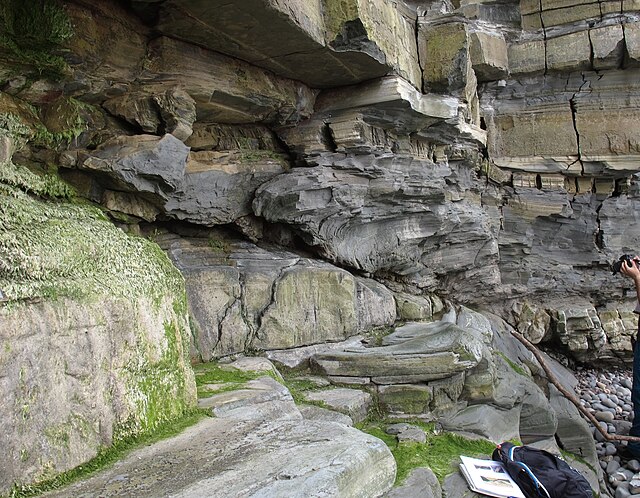The Moine Thrust Belt or Moine Thrust Zone is a linear tectonic feature in the Scottish Highlands which runs from Loch Eriboll on the north coast 190 kilometres (120 mi) south-west to the Sleat peninsula on the Isle of Skye. The thrust belt consists of a series of thrust faults that branch off the Moine Thrust itself. Topographically, the belt marks a change from rugged, terraced mountains with steep sides sculptured from weathered igneous, sedimentary and metamorphic rocks in the west to an extensive landscape of rolling hills over a metamorphic rock base to the east. Mountains within the belt display complexly folded and faulted layers and the width of the main part of the zone varies up to 10 kilometres (6.2 mi), although it is significantly wider on Skye.

The Glencoul Thrust, part of the Moine Thrust Belt, dipping downwards from left to right, where Precambrian Lewisian gneiss has been pushed along the thrust fault and now lies above younger well-bedded Cambrian quartzite, which itself lies unconformably above Lewisian gneiss
The Moine Thrust at Knockan Crag, in the central section of the thrust belt. Neoproterozoic Moine schists are thrust over Cambrian–Ordovician Durness Group dolomites
A thrust fault is a break in the Earth's crust, across which older rocks are pushed above younger rocks.
Thrust fault in the Qilian Shan, China. The older (left, blue, and red) thrust over the younger (right, brown).
The Glencoul Thrust at Aird da Loch, Assynt in Scotland. The irregular grey mass of rock is formed of Archaean or Paleoproterozoic Lewisian gneisses thrust over well-bedded Cambrian quartzite, along the top of the younger unit.
Small thrust fault in the cliffs at Lilstock Bay, Somerset, England; displacement of about two metres (6.6 ft)
Antiformal stack of thrust imbricates proved by drilling, Brooks Range Foothills, Alaska





